Mistyczny kontakt z Bogiem w Księdze światła ukrytego (Sefer ha-bahir)
Mystical Rapport with God in the Book of the Hidden Light (Sefer ha-bahir)
Author(s): Wojciech BrojerSubject(s): Jewish Thought and Philosophy, History of Judaism
Published by: Żydowski Instytut Historyczny
Keywords: Sefer ha-bahir; Book of illumination; Book of Hidden Light; kabbalah; Jewish mysticism; ma‘ase merkava; Torah; prayer; offering; mystical ascent; mystical descent; theurgy
Summary/Abstract: Sefer ha-bahir, The Book of the Hidden Light, written around the middle of the 13th century, was the response of the Languedoc mystics milieu to the appearance of the Talmud among European Jews. In the 12th and 13th century, the tosafists, the successors to Rashi, the first Ashkenazi commentator of the Babylonian tradition, were exerting increasingly strong pressure on the diaspora to accept Talmud as the only true (written) Oral Torah (Tora she-be-‘al pe), revealed to Moses on Mount Sinai. The authors of Sefer ha-bahir were forced to record their own tradition as the Oral Torah. The dispute concerned not only the content of the competing traditions but first of all the paths of the Divine revelation thereof. The Talmudists ruled out the presence of the spirit of prophesizing in Israel following the demolition of the Temple. As they built the tradition of Talmud over the centuries, they believed that they only predict and reproduce based on rational rules the Sinai revelation, received by means of a continuous relay of the generations (seder ha-kabala) going back to Moses and Aaron. This approach was countered by the mysticism of the merkava and the abundant visionary literature (hekhalot), based on the view that also after the demolition of the Temple an uninterrupted contact with the Divine world, the discovering of its secrets, the gift of prophecy and a new revelation are possible, provided that certain conditions are met. This conviction was cherished by the leading authorities of the diaspora, Jehuda ha-Levi, Maimonides, the Rhineland pietists. It was also shared by the Languedoc mystics. According to their declaration, it was precisely in this manner, through mystical contact with God, that Israel actually received the direct revelation of the Oral Torah, recorded in the Book of the Bright. The article seeks to demonstrate that the authors of the treatise accomplished a profound change of the mystical perceptions and of the model of contact with God. The mechanism serving such communion, developed by traditional mystics and commonly accepted in the Middle Ages, was the individual ascension (‘ala) of the mystagogue, or his soul and thoughts, over the successive stages of the journey toward the Divine chariot and the attachment (devekut) to God or Its aspect (glory, shekhina, sefirot). In Sefer ha-bahir the study of the Torah and prayer release an immediate and collective contact with the superior world, they force the descent of God (jerida Jhvh) to Israel, its communion with the latter and the vesting of the gift of prophecy in it. At the same time, this act has a theurgical dimension, influencing the condition of the Divine world and restoring unity (jichud) to the Divine pleroma. In The Book of the Hidden Light, we see the creation of a mystical mechanism that will dominate the imagination of the Polish Hassidim in the future.
Journal: Kwartalnik Historii Żydów
- Issue Year: 269/2019
- Issue No: 01
- Page Range: 11-28
- Page Count: 18
- Language: Polish

